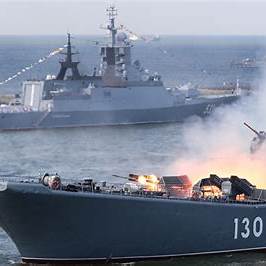Tehran, Iran – In a significant show of military cooperation, Iran, China, and Russia have launched their annual joint naval exercises in the Gulf of Oman and the northern Indian Ocean. The drills, dubbed Maritime Security Belt 2025, come at a time of heightened geopolitical tensions, with U.S. foreign policy shifts under President Donald Trump straining Western alliances.
Strategic Military Cooperation in Key Waters
The joint exercises, which began on Monday, aim to enhance maritime security, combat piracy, and foster closer military ties between the three nations. Iran’s Rear Admiral Mostafa Tajaddini emphasized that the drills will focus on “rescue operations, counterterrorism, and safeguarding vital trade routes.”
“These exercises demonstrate our commitment to regional stability and the development of a multipolar world order,” a statement from China’s Ministry of National Defense read.
The drills involve warships, helicopters, and marine special forces units from all three countries, showcasing a growing strategic partnership that challenges Western military dominance in the region.
Trump’s Foreign Policy Realignment Fuels Global Shifts
The timing of the exercises coincides with a major realignment in U.S. foreign policy, as President Trump pushes for a shift away from traditional alliances with Europe and NATO. His administration’s decision to reduce military commitments in the Middle East and his ongoing confrontations with Western allies have raised concerns among European nations, while simultaneously emboldening U.S. adversaries.
“Trump’s approach to international relations has created a vacuum, one that China, Russia, and Iran are keen to fill,” said military analyst Michael Clarke. “These drills are a direct signal that these powers are deepening their cooperation to counterbalance Western influence.”
Rising Tensions in the Indo-Pacific and the Middle East
The naval drills also send a message amid rising tensions in the Indo-Pacific, where China continues to assert its territorial claims, and in the Middle East, where Iran faces continued U.S. sanctions and increasing diplomatic isolation.
Russia, engaged in its ongoing conflict with Ukraine, sees the exercises as an opportunity to reinforce its global military partnerships while demonstrating resilience against Western sanctions.
Meanwhile, China, locked in strategic competition with the U.S. over trade and security in the Indo-Pacific, is using the naval drills to expand its influence beyond the South China Sea.
Western Allies on Alert
As the Iran-China-Russia alliance strengthens, Western powers are closely monitoring the situation. The Pentagon has condemned the exercises as “provocative,” while NATO officials have urged increased military cooperation among Western allies to counter the growing influence of China and Russia.
“The West cannot afford to be complacent,” a senior NATO official stated. “These drills underscore the need for a unified and proactive defense strategy.”
A New Era of Global Power Struggles
The annual naval drills underscore a shifting global power structure, with emerging alliances reshaping international security dynamics. As the United States redefines its global commitments, nations like Iran, China, and Russia are seizing the opportunity to bolster their strategic cooperation.
While the exercises are officially framed as promoting maritime security, they also serve as a powerful geopolitical statement. With the future of Western alliances uncertain under Trump’s leadership, the balance of global power continues to evolve in unpredictable ways.


